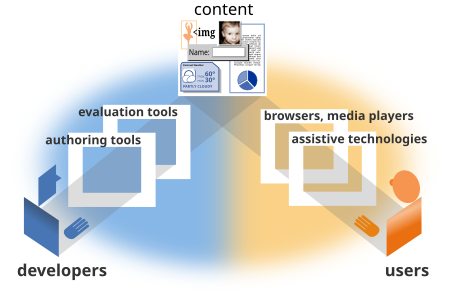Essential Components of Web Accessibility
Introduction
It is essential that several different components of web development and interaction work together in order for the web to be accessible to people with disabilities. These components include:
- content - the information in a web page or web application, including:
- natural information such as text, images, and sounds
- code or markup that defines structure, presentation, etc.
- web browsers, media players, and other “user agents”
- assistive technology, in some cases - screen readers, alternative keyboards, switches, scanning software, etc.
- users’ knowledge, experiences, and in some cases, adaptive strategies using the web
- developers - designers, coders, authors, etc., including developers with disabilities and users who contribute content
- authoring tools - software that creates websites
- evaluation tools - web accessibility evaluation tools, HTML validators, CSS validators, etc.
How the Components Relate
Web developers usually use authoring tools and evaluation tools to create web content.
People (“users”) use web browsers, media players, assistive technologies, or other “user agents” to get and interact with the content.
Interdependencies Between Components
There are significant interdependencies between the components; that is, the components must work together in order for the web to be accessible. For example, for alternative text on images:
- technical specifications address alternative text (for example, HTML defines the alternative text attribute (
alt) of the image element (img)) - WAI guidelines (WCAG, ATAG, UAAG described below) - define how to implement alternative text for accessibility in the different components
- developers provide the appropriate alternative text wording
- authoring tools enable, facilitate, and promote providing alternative text in a web page
- evaluation tools are used to help check that alternative text exists
- user agents provide human and machine interface to the alternative text
- assistive technologies provide human interface to the alternative text in various modalities
- users know how to get the alternative text from their user agent and/or assistive technology as needed
The Implementation Cycle
When accessibility features are effectively implemented in one component, the other components are more likely to implement them.

- When web browsers, media players, assistive technologies, and other user agents support an accessibility feature, users are more likely to demand it and developers are more likely to implement it in their content.
- When developers want to implement an accessibility feature in their content, they are more likely to demand that their authoring tool make it easy to implement.
- When authoring tools make a feature easy to implement, developers are more likely to implement it in their content.
- When an accessibility feature is implemented in most content, developers and users are more likely to demand that user agents support it.
When One Component is Weak
If an accessibility feature is not implemented in one component, there is little motivation for the other components to implement it when it does not result in an accessible user experience. For example, developers are unlikely to implement an accessibility feature that authoring tools do not support and that most browsers or assistive technologies do not implement consistently.
If one component has poor accessibility support, sometimes other components can compensate through “work-arounds” that require much more effort and are not good for accessibility overall. For example,
- developers can do more work to compensate for some lack of accessibility support in authoring tools; for example, coding markup directly instead of through a tool
- users can do more work to compensate for some lack of accessibility support in browsers, media players, and assistive technology and lack of accessibility of content; for example, using different browsers or assistive technologies to overcome different accessibility issues
However, in most cases the works-arounds are not implemented and the result is still poor accessibility. Additionally, sometimes poor accessibility support in one component cannot be reasonably overcome by other components and the result is inaccessibility, making it impossible for some people with disabilities to use a particular website, page, or feature.
Guidelines and Other Standards
The World Wide Web Consortium (W3C) Web Accessibility Initiative (WAI) develops web accessibility standards for the different components:
- Authoring Tool Accessibility Guidelines (ATAG) Overview addresses authoring tools
- WCAG 2 Overview addresses web content, and is used by developers, authoring tools, and accessibility evaluation tools
- User Agent Accessibility Guidelines (UAAG) Overview addresses web browsers and media players, including some aspects of assistive technologies
These accessibility guidelines are based on the fundamental technical specifications of the web, and are developed in coordination with all W3C technical specifications (HTML, CSS, SVG, SMIL, etc.). W3C also develops technical specifications that directly address accessibility, including:
- ARIA, the Accessible Rich Internet Applications Suite, which defines a way to make web applications more accessible to people with disabilities. It especially helps with dynamic content and advanced user interface controls developed with Ajax, HTML, JavaScript, and related technologies.
For more information, see W3C Accessibility Standards Overview.
Back to Top

